Panel 1: Seafood safety: How do we assess the
advertisement
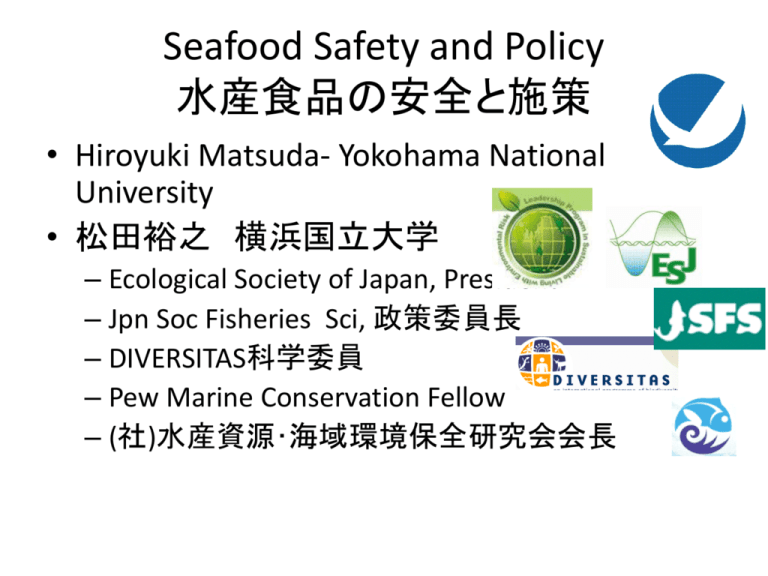
Seafood Safety and Policy 水産食品の安全と施策 • Hiroyuki Matsuda- Yokohama National University • 松田裕之 横浜国立大学 – Ecological Society of Japan, President – Jpn Soc Fisheries Sci, 政策委員長 – DIVERSITAS科学委員 – Pew Marine Conservation Fellow – (社)水産資源・海域環境保全研究会会長 Nov. 12: Panel 1: Seafood safety: How do we assess the safety of seafood? 1. 2. 3. 4. 5. Dr. Mitsuyoshi Urashima 浦島充佳, 慈恵医大 Why risk perception is much higher than real risk? なぜリスクは現実よりもずっと高いと認識されるか Dr. Kazuo Sakai 酒井一夫, 放医研 From a viewpoint of radiation protection -- to reduce/control exposure to the public— 放射線防護の視点から被曝の減衰・制御のために Prof. Deborah Oughtonデボラ・アウトン, University of Oslo Norway, Fish and Chernobyl ノルウェー、魚、チェルノブイリ Mr. Koji Hasebe 長谷部耕二, 讀賣新聞 The fears of people against radiation exposure 放射線被曝に対する人々の恐れ Dr. Takami Morita 森田貴己, 水産庁 Comparison of regulatory limits for fishery products 水産物の基準値の国別比較 浦島充佳氏 Why risk perception is much higher than real risk? • Radiation is invisible: Smoking is avoidable because it can be seen. • Radiation is not controllable: Food poisoning by pathogenic E Coli was avoidable by heating meat. • Children’s issue: Dividing cells may be more sensitive to radiation induced toxicity, theoretically. • Long lasting: Not 1 year’s problem, but will continue decades. • Uncertainty: We have only a few evidence of low dose radio-contamination in history. Concentrations in meal in Fukushima Cs-137 Cs-134 K-40 <1 Bq/kg (Coop Fukushima) 2 families detection(max; 3.2 Bq/kg) in 100 families. http://www.fukushima.coop/kagezen/2012.html 酒井一夫氏一部加筆 Dose Received through Food Annual Internal Exposure (mSv) (Maximum Value) Actual intake = 4Bq/day Actual inner exposure level is 1/40 of 1mSv/yr. Radioactive Cesium Naturally Occurring Radioactivity Based on “Monitoring of Daily Food in Fukushima” http://www.pref.fukushima.jp/j/nitijyousyoku0924.pdf 酒井一夫氏 Authorities Standards Producers Monitoring Information Control/Advice Market Management Information Information Consumers Understanding /Acceptance Safety and “Peace of Mind” regarding Food of Fukushima 7Deborah Oughton: ICRP Fukushima dialogues, November 2012 Chernobyl: Radioceasium deposition in Norway, 1986 Oughton氏 Maximum values ‘86/’87 Cow milk: 650 Bq/kg Goat milk: 1350 Bq/kg Freshwater fish: 30 000 Bq/kg Lamb: 40 000 Bq/kg Reindeer: 150 000 Bq/kg Photo: Lavrans Skuterud, NRPA Mushrooms: 1-2 MBq/kg In 1987 more than 90% of all reindeer meat in Norway was above 600 Bq/kg Permitted levels 600 Bq/kg general foodstuffs Raised permitted levels to 6000 Bq/kg in reindeer (+mushrooms, game, freshwater fish) 長谷部耕二氏 買い叩かれる原発付近の食品 • Spinach Gunma 250円($3) Kyoto 498円($5) • Komatu-na Chiba 198円($ 2.5) Kyoto 498円($5) 森田貴己氏 Comparison of regulatory limits for fishery products Cs-134 + Cs-137 (Bq/kg-wet) Codex 1000 * Japan 500 → 100 USA 1200 EU 1250 Thai 500 Singapore 500 South Korea 370 Hong Kong 1000 Chinese Taipei 370 Philippines 1000 Vietnam 1000 Malaysia 1000 China 800 * This index includes S-35, Co-60, Sr-89, Ru-103, Ce-144, Ir-192 500 400 300 Hokkaido マダラ 森田貴己氏 500 Miyagi 400 300 200 200 100 100 0 0 500 Aomori 400 500 Fukushima 400 300 300 200 200 100 100 0 500 0 Iwate 400 3/1 7/1 11/1 3/1 7/1 11/1 300 ― 500Bq/kg The provisional regulation values 200 100 ―100Bq/kg The regulatory limit 0 3/1 7/1 11/1 3/1 7/1 11/1 森田貴己氏より マダラの経済規模と出荷規制 Prefecture Production value in 2010 (100million yen: 億円) Restricted distribution Hokkaido 46.8 (Pacific side) - Aomori 8.6 (Pacific side) 2012.8.27~10.31 Iwate 10.4 2012.5.2~ (a part of areas) Miyagi 21.2 2012.5.2~ Fukushima 2.9 After accident ~ Ibaragi 0.4 2012.11.9~ 論点 • 実際の被曝リスクはバナナのK-40、魚の水銀と比べ て十分低い(が0でない) Actual risk level is much smaller than K-40 in banana and mercury in fish • 政府と科学者が市民に信頼されていない Citizens distrust government and scientists • 消費者よりも流通が気にする Market rather than consumers worries about contamination. • 双方の「選択の自由」を尊重する Respect both sides of freedom of choice • 食べる利益も説明する(魚、被災地) Explain risk and benefit of eating fish and supporting Fukushima. A home delivery company大地を守る会 sells BOTH less contaminated foods and foods from Fukushima One reason why we conserve nature is rebuilding linkage between producers and consumers(鬼頭秀一) http://yellow.ap.teacup.com/thinkmon/1194.html http://pub.ne.jp/newjei/?entry_id=3823685 差別Discrimination to radioactive contamination • Discrimination in even the Kyoto traditional religious events • Pine woods with prayers’ message, almost no contaminated, were rejected to be burn in Kyoto religious event (August 16, 2011) • Garage sales of agriculture/fisheries products of Fukushima in Fukuoka was cancelled. http://www.asahi.com/national/update/0925/TKY201109250289.html 14

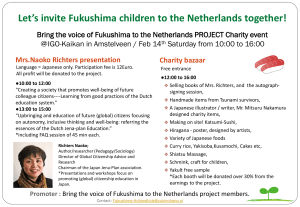
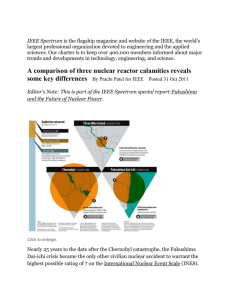
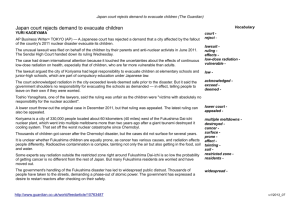
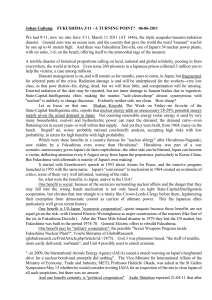
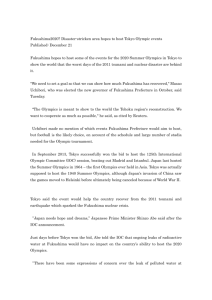
![New Comprehensive Special Business Plan Tokyo Electric Power Company [January 15, 2014]](http://s2.studylib.net/store/data/011184152_1-701953b23859a135e05763b1e85232b2-300x300.png)